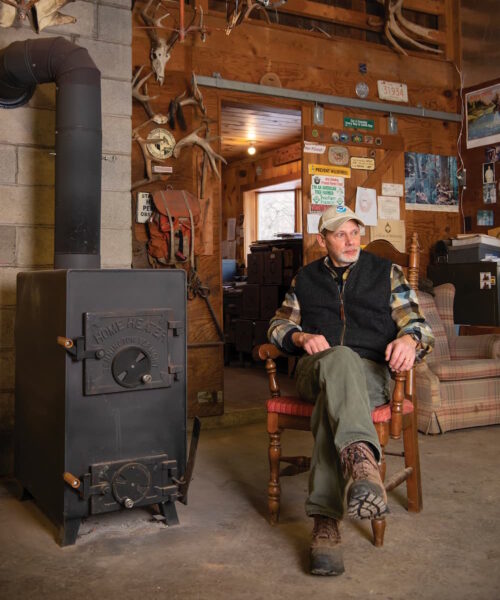February 25, 2022
By Brandee Coleman Gilmore
The stirring scent of a wood fireplace is the first thing you notice at Great Mountain Forest’s Forestry Office in Norfolk. The weathered pine garage is filled with tools, organized to the hilt. Friendly foresters emerge clad in Carhartt and denim. At the center is a broken-in set of furniture. You get the sense it’s hard work around here, but it’s family, too.
Russell Russ of Colebrook took over as the daily weather observer for GMF’s National Weather Service Cooperative Station in 2003. His father, Darrell Russ, had suffered a stroke and could no longer mind the precious task he’d been doing on a volunteer basis since the 1950s. Russell had absorbed a lot as a kid, but the chance to ask questions was gone.
“That was tough… he wanted to tell me, but he couldn’t get it out. So I had to rely on old notes.”
There was no shortage of those. Darrell’s lengthy service was only outdone by the 60 volunteer years Edward ‘Ted’ Childs—the weather observation station’s founder—had put in. Mr. Childs, as Russell refers to him, took an interest in the weather at a young age. During his studies at Yale, he’d set up a weather recording station on his family’s estate (just down the lane from the present-day forestry office). On New Year’s Day 1932, he started taking daily readings and by 1942, Russell says, the National Weather Service came calling to see how legitimate the operation was, to decide if they should let it into their network.
“They said, ‘Holy cow. This guy’s made his own weather sheets. He’s recording everything. He’s there every day… and he’s meticulous!’” explains Russell.

‘Norfolk 2SW’ became one of the National Weather Service’s most prized locations because it lacked vulnerability to development. They figured it might make for years of consistent readings.
Mr. Childs delivered for decades.
For 90 years now, one of these three men (and just a handful of others) has gotten up and trudged through all Mother Nature can muster to meticulously record daily temperature and precipitation readings. Their reports collaborate with nearly 12,000 cooperative National Weather Service stations like it around the country to make large-scale forecasting and analysis possible.
“We get high marks from the weather service, rarely do we have errors,” remarks Russ.
Some of the 1932-era weather instrumentation still meets the standard for official readings (they’ve got two, newer digital sets for backup), and Russell totes the same handmade, worn clipboards his dad and Mr. Childs used. He says one thing has changed for good, though—Excel spreadsheets over crunching numbers manually at the end of the month.
These days, it’s harder and harder to find volunteers to do this thankless but imperative work, so the job is often tied to paid positions. But for this part of Russ’s job as GMF Forester, the motivation goes beyond money.
“They did it for so long, and I watched them do it as a kid… the fact that I can carry that on, that’s very important for me.”






















